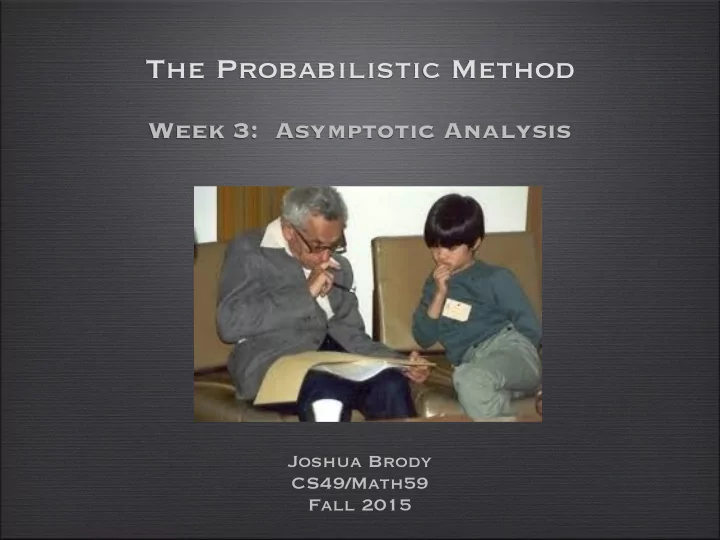

The Probabilistic Method Week 3: Asymptotic Analysis Joshua Brody CS49/Math59 Fall 2015
Clicker Question Let f(n) = n 2 + 17n and g(n) = 10n 2 -n/1000 . Which answer most accurately represents the relationship between f and g? (A) f(n) = Ɵ (g(n)) (B) f(n) = O(g(n)) (C) f(n) = Ω (g(n)) (D) f(n) = o(g(n)) (E) f(n) = ω (g(n))
Clicker Question Let f(n) = n 2 + 17n and g(n) = 10n 2 -n/1000 . Which answer most accurately represents the relationship between f and g? (A) f(n) = Ɵ (g(n)) (B) f(n) = O(g(n)) (C) f(n) = Ω (g(n)) (D) f(n) = o(g(n)) (E) f(n) = ω (g(n))
Clicker Question Suppose that f = o(g). Which of the following values for f(n) and g(n) are possible? (A) f(n) = n, g(n) = 10n (B) f(n) = n 3 , g(n) = 100n 2 (C) f(n) = n log n, g(n) = 10n 2 (D) f(n) = 10n, g(n) = 2 2 + log(n) (E) multiple answers possible.
Clicker Question Suppose that f = o(g). Which of the following values for f(n) and g(n) are possible? (A) f(n) = n, g(n) = 10n (B) f(n) = n 3 , g(n) = 100n 2 (C) f(n) = n log n, g(n) = 10n 2 (D) f(n) = 10n, g(n) = 2 2 + log(n) (E) multiple answers possible.
Transitivity of Asymptotic Notations Facts: Let f,g,h be functions. (1)if f = O(g) and g = O(h) , then f = O(h) . (2)If f = Ω (g) and g = Ω (h) , then f = Ω (h) . (3)If f = Ɵ (g) and g = Ɵ (h) , then f = Ɵ (h) . (4)If f = o(g) and g = o(h) , then f = o(h) . (5)If f = ω (g) and g = ω (h) , then f = ω (h) . (6)If f ~ g and g ~ h , then f ~ h .
Asymptotic Notation • f(n) = O(g(n)) if there exists constants c,n 0 >0 such that for all n ≥ n 0 , f(n) ≤ cg(n) • f(n) = Ω (g(n)) if there exists constants c,n 0 >0 such that for all n ≥ n 0 , f(n) ≥ cg(n) • f(n) = Ɵ (g(n)) if there are constants c 1 ,c 2 ,n 0 >0 such that for all n ≥ n 0 , c 1 g(n) ≤ f(n) ≤ c 2 g(n)
Asymptotic Notation • f(n) = o(g(n)) if for all constants c>0 there exists n 0 > 0 such that for all n ≥ n 0 , f(n) < cg(n) • f(n) = ω (g(n)) if for all constants c>0 there exists n 0 >0 such that for all n ≥ n 0 , f(n) > cg(n)
Asymptotic Properties Facts: Let f,g,h be functions. (1) if f = O(g) and g = o(h) , then f = o(h) . (2) If f = O(h) and g = O(h) , then f+g = O(h) . (3) If f 1 ,...,f k = O(h) then f 1 +...+f k = O(h) as long as k is constant. (4) If f 1 = O(g 1 ) and f 2 = O(g 2 ) , then f 1 +f 2 = O(g 1 +g 2 ) . (5) If f 1 = O(g 1 ) and f 2 = O(g 2 ) then f 1 f 2 = O(g 1 g 2 ).
The Probabilistic Method
Recommend
More recommend